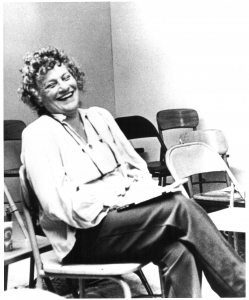Pointer # 9 – The energy released in solving the problem, flowing through the Where, Who, and What, forms the scene.
Taken from “Improvisation for the Theater” by Viola Spolin; 3rd Edition, Northwestern University Press.
I believe creating story should not be the primary focus in improv work. Story is the trap. Rather allow story to emerge from a solid focus that keeps everyone engaged in seeking its solution. Story is the result of that process and not the goal.
Story comes into being in the wake of seeking a solution to a problem. Finding the story any other way constitutes being in your head. Creating narrative through things like a story spine is a technique that writers use. Keeping the idea of making a story by adding information and accepting all offers is a kind of authoring process. It is playwriting.
It often comes from the head and does not have the dynamic power of watching a group of people solve a particular problem or set of problems intuitively. Intuition being that facility that unifies intellect with action spontaneously to create energy, drama, and the excitement of discovering solutions in the moment.
The Long-Form Imperative
When finding/creating story is the primary focus, (as is the case in most long form improv), true player-to-player connection is limited. The only thing worthwhile when playing in a long-form Improv is when actors give each other immediate problems to solve within the scene. That true connection is what the audience came to see. Once that happens, the other players, (or even the players themselves), having discovered a moment of true, spontaneous relation and direct experience then use Yes, and… to move the story along.
Using Yes, and… calls on the actor(s) to add more information to service a story and then incorporate that information. This is what bogs down the playing.
The sorting and integration of information becomes the focus in a long form.
Solving that narrative problem (re-incorporation, tilts, etc.) is a legitimate focus but the constant addition of information comes mostly from several heads busily playwriting quickly. Clever actors do indeed incorporate this information and can make some good comedy from it, but it lacking an important quality – True theatricality.
Whenever I’ve seen long form I miss the energy of actors spontaneously solving a particular problem within a Who, What and Where. i.e., Making Contact, Gibberish, What’s Beyond, Showing Where, etc. – problems mostly considered the focus of “Short-Form” games.
I miss seeing actors in direct relation to each other and wrestle with the problems (focus), all working within that framework, however long it takes. The outcome (solution) is unknown and not known in advance by both players and audience.
Keep working on those problems and see if a theme emerges (as in a Harold) or add the focus of keeping to a theme in a series of shorter scenes, or go for Transformation that of one scene sparking the next through, “Heighten and Explore”.
Don’t fit those flashes of intuitive connection into a story – Revel in the unknown and remain there as long as possible. The outcome will be nothing short of miraculous!

I am loving my time in your class learning about Viola Spolin’s work from you, who studied with her firsthand for 9 years. I tell my own acting students not to get bogged down with playwriting which will keep them up in their head. Someone else will have already written the script. It is their job to bring it to life. Viola’s theater games help actors create characters who are living life more fully – and in the moment.
Amen!